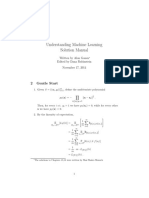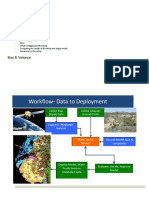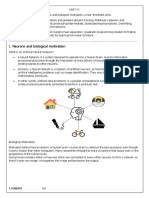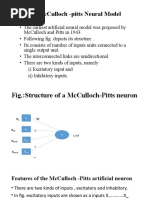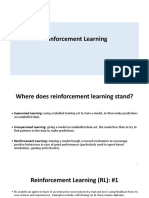Introduction To Deep Learning - Assignment
Uploaded by
sayantani 11Introduction To Deep Learning - Assignment
Uploaded by
sayantani 11t
aa
Module 1: Introduction
to Deep Learning - Assignment
lliP
te
In
Contact us: support@intellipaat.com / © Copyright Intellipaat / All rights reserved
Artificial Intelligence Certification Course
Introduction:
Deep learning, a subset of machine learning, has revolutionized the field of
artificial intelligence by enabling machines to learn from data in a way that mimics
human learning at a fundamental level. As this technology continues to advance, it
becomes increasingly important for professionals to grasp the core principles that
underpin deep learning algorithms and architectures.
The objective of this assignment is to evaluate the foundational knowledge of deep
learning through a series of carefully crafted multiple-choice questions (MCQs).
t
These questions are designed to test various aspects of deep learning, including
aa
its history, fundamental concepts, key architectures, and the underlying
mathematics. The MCQ format is chosen for its ability to assess a wide range of
topics succinctly and to provide immediate feedback on the learner's
understanding.
lliP
The assignment consists of 10 MCQs, each with a single or multiple correct
answers.
1. Which industries commonly use Deep Learning for image recognition applications?
a. Healthcare
b. Manufacturing
te
c. Retail
d. All of the above
2. What distinguishes Deep Learning from traditional Machine Learning?
In
a. Depth of Neural Networks
b. Type of Algorithms used
c. Machine Learning is an evolution of Deep Learning
d. Volume of data processed
i. a,d
ii. a,b,c,d
iii. a,c,d
iv. a,b
Contact us: support@intellipaat.com / © Copyright Intellipaat / All rights reserved
Artificial Intelligence Certification Course
3. Which metrics are commonly used to evaluate the performance of a classification
model?
a. Mean squared error
b. Root mean squared error
c. F1 score
d. R-squared
4. Which of the following are the key components of Deep Learning (DL)?
t
a. Decision Trees
aa
b. Neural Networks
c. Support Vector Machines
d. K-Means Clustering
5. What are the main challenges in training deep neural networks?
lliP
a. Lack of labeled data
b. Overfitting
c. Underfitting
d. None of the above
6. Which technology is a subset of AI and focuses on training models to learn
te
from data?
a. Artificial Intelligence
b. Machine Learning
In
c. Deep Learning
d. Data Science
7. In the context of Deep Learning, what is a neural network?
a. A network of interconnected computers
b. A network of interconnected neurons
c. A network of interconnected databases
d. A network of interconnected algorithms
Contact us: support@intellipaat.com / © Copyright Intellipaat / All rights reserved
Artificial Intelligence Certification Course
8. What is the role of hyperparameter tuning in the model evaluation phase?
a. To adjust the learning rate
b. To optimize model parameters for better performance
c. To select features
d. To preprocess the data
9. What is the primary goal during the project initiation phase of a Deep Learning
project?
t
a. Model training
aa
b. Define the problem and scope
c. Hyperparameter tuning
d. Data collection
10. Why is continuous monitoring important in the life cycle of a deployed Deep
Learning model?
lliP
a. To retrain the model from scratch
b. To ensure the model adapts to changing data patterns
c. To deploy a new model version daily
d. To skip the model evaluation phase
te
In
Contact us: support@intellipaat.com / © Copyright Intellipaat / All rights reserved
You might also like
- Introduction To Machine Learning Assignment-Week 4No ratings yetIntroduction To Machine Learning Assignment-Week 45 pages
- Understanding Machine Learning Solution Manual: 2 Gentle StartNo ratings yetUnderstanding Machine Learning Solution Manual: 2 Gentle Start67 pages
- Assignment 11: Introduction To Machine Learning Prof. B. Ravindran100% (1)Assignment 11: Introduction To Machine Learning Prof. B. Ravindran3 pages
- Assignment - Week 6 (Neural Networks) Type of Question: MCQ/MSQNo ratings yetAssignment - Week 6 (Neural Networks) Type of Question: MCQ/MSQ4 pages
- Introduction To Machine Learning - IITKGP - Unit 4 - Week 2No ratings yetIntroduction To Machine Learning - IITKGP - Unit 4 - Week 25 pages
- Deep Learning - IIT Ropar - Unit 4 - Week 1No ratings yetDeep Learning - IIT Ropar - Unit 4 - Week 18 pages
- Introduction To Machine Learning - Unit 4 - Week 2100% (1)Introduction To Machine Learning - Unit 4 - Week 23 pages
- Deep Learning - IIT Ropar - Unit 4 - Week 1No ratings yetDeep Learning - IIT Ropar - Unit 4 - Week 15 pages
- Assignment 3: Introduction To Machine Learning Prof. B. RavindranNo ratings yetAssignment 3: Introduction To Machine Learning Prof. B. Ravindran4 pages
- Artificial Intelligence - Knowledge Representation and Reasoning - Unit 8 - Week 5100% (1)Artificial Intelligence - Knowledge Representation and Reasoning - Unit 8 - Week 55 pages
- Assignment 2: Introduction To Machine Learning Prof. B. Ravindran100% (1)Assignment 2: Introduction To Machine Learning Prof. B. Ravindran3 pages
- Assignment 11: Introduction To Machine Learning Prof. B. Ravindran100% (2)Assignment 11: Introduction To Machine Learning Prof. B. Ravindran3 pages
- Answers For End-Sem Exam Part - 2 (Deep Learning)No ratings yetAnswers For End-Sem Exam Part - 2 (Deep Learning)20 pages
- Assignment 1: Introduction To Machine Learning Prof. B. RavindranNo ratings yetAssignment 1: Introduction To Machine Learning Prof. B. Ravindran4 pages
- Assignment 4 (Sol.) : Introduction To Machine Learning Prof. B. RavindranNo ratings yetAssignment 4 (Sol.) : Introduction To Machine Learning Prof. B. Ravindran4 pages
- Deep Learning - IIT Ropar - Unit 6 - Week 3No ratings yetDeep Learning - IIT Ropar - Unit 6 - Week 34 pages
- Assignment 6 (Sol.) : Introduction To Machine Learning Prof. B. RavindranNo ratings yetAssignment 6 (Sol.) : Introduction To Machine Learning Prof. B. Ravindran10 pages
- DEEP LEARNING IIT Kharagpur Assignment - 5 - 2024No ratings yetDEEP LEARNING IIT Kharagpur Assignment - 5 - 20249 pages
- SRM Valliammai Engineering College (An Autonomous Institution)No ratings yetSRM Valliammai Engineering College (An Autonomous Institution)9 pages
- Reinforcement Learning - Unit 6 - Week 4No ratings yetReinforcement Learning - Unit 6 - Week 43 pages
- Artificial Neural Networks Quiz Questions 1No ratings yetArtificial Neural Networks Quiz Questions 117 pages
- Deep Learning - IIT Ropar - Unit 12 - Week 9No ratings yetDeep Learning - IIT Ropar - Unit 12 - Week 94 pages
- Artificial Intelligence - Knowledge Representation and Reasoning - Unit 5 - Week 2No ratings yetArtificial Intelligence - Knowledge Representation and Reasoning - Unit 5 - Week 26 pages
- Introduction To Machine Learning - Unit 3 - Week 1No ratings yetIntroduction To Machine Learning - Unit 3 - Week 13 pages
- Introduction To Machine Learning - IITKGP - Unit 5 - Week 3No ratings yetIntroduction To Machine Learning - IITKGP - Unit 5 - Week 34 pages
- ICA-Authentic Cricket Playing Surfaces 2.7.2024No ratings yetICA-Authentic Cricket Playing Surfaces 2.7.202461 pages
- Fashion Recommendation System Using Machine LearningNo ratings yetFashion Recommendation System Using Machine Learning8 pages
- Transformer-Based_Approach_for_Joint_Handwriting_aNo ratings yetTransformer-Based_Approach_for_Joint_Handwriting_a29 pages
- Mcculloch-Pitts Neural Model and Pattern Classification.No ratings yetMcculloch-Pitts Neural Model and Pattern Classification.13 pages
- PSIT104 Soft Computing Techniques: ObjectiveNo ratings yetPSIT104 Soft Computing Techniques: Objective2 pages
- Food Classification Using Deep Learning Ijariie14948No ratings yetFood Classification Using Deep Learning Ijariie149487 pages
- Recurrent Neural Networks: Prof. Gheith AbandahNo ratings yetRecurrent Neural Networks: Prof. Gheith Abandah32 pages
- A Survey On Deep Learning Techniques For Medical Image Analysis Riyaj100% (1)A Survey On Deep Learning Techniques For Medical Image Analysis Riyaj20 pages
- AI Techniques For Stability Analysis and Control in Smart GridsNo ratings yetAI Techniques For Stability Analysis and Control in Smart Grids28 pages
- Reading Comprehension - Magazine Article " Artificial Intelligence May Doom The Human Race Within A Century, Oxford Professor Says"No ratings yetReading Comprehension - Magazine Article " Artificial Intelligence May Doom The Human Race Within A Century, Oxford Professor Says"5 pages
- Neuro AI - Intelligent Systems and Neural Networks: PrefaceNo ratings yetNeuro AI - Intelligent Systems and Neural Networks: Preface14 pages
- Forecasting at Uber: A Brief Survey: Andrea PasquaNo ratings yetForecasting at Uber: A Brief Survey: Andrea Pasqua53 pages
- IEEE Conference On Snake Species Identification ReviewNo ratings yetIEEE Conference On Snake Species Identification Review5 pages



